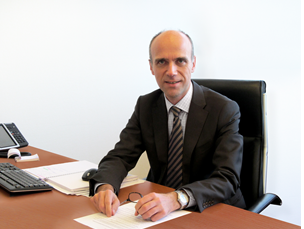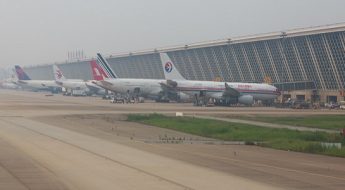
copyright ©ADP Ingénierie & Zaha Hadid architects
A Giant is rising at Daxing. The new airport in Beijing is planned for completion in May 2019 and will start trial operations late that year, according to China Daily. Olivier Berger, CEO of ADP INGENIERIE, subsidiary of the GROUPE ADP, discussed key challenges and design consideration of this giant project with Martin Lamprecht of Momberger Airport Information.
The new airport in Beijng airport is planned for completion in May 2019 and will start trial operations late that year, according to China Daily. Initially, it is expected to serve 45 million passengers annually, but the new facility is designed to handle 72 million passengers, 2 million tones of cargo, and 620,000 aircraft movements in 2025. Airport construction began in December 2014 but the facility has not been given an official name. It is located between Beijing’s Daxing district and the suburbs of Hebei’s Langfang city, 46 kilometers south of Beijing’s center. Straight-line distance to Beijing Capital International Airport, the city’s current international airport, is 67 km. A 66-km rapid transit rail line will be built linking northern Beijing to the new airport in the south, passing underground through the center of the city.
In planning the new Beijing airport, what where the major design challenges and objectives?

Olivier Berger, CEO of ADP INGENIERIE, subsidiary of the GROUPE ADP
Olivier Berger: The most innovative concept of the terminal planning is undoubtedly the centralized functional concept. It will allow the best communication between all airport actors (concessionaires, airlines, authorities and operators) and it will give the best quality of service to the terminal. It provides as well the best process visibility to passengers while avoiding the use of an APM (automatic people mover).
The centralized functional concept brought us to stack vertically the different terminal processes. It will be the first airport with two departure levels and two arrival levels. This will increase flexibility between international and domestic operations and increase building compactness. It will also allow the pooling of BHS (baggage handling system) equipment and finally also centralize the landside access for both international and domestic passengers. This concept is clearly visible in the terminal shape with one centralized processor connecting five radius piers. Our project offers the best possible passenger experience:
- through straightforward flows and connections by short walking distances through clear spaces and gardens;
- the best possible operation ability through the centralized process, smooth aircraft circulation, flexibility for unknown future traffic and processes;
- the best profitability through efficient commercial areas on landside and on airside, clearly visible by all departing passengers;
- and the best sustainable approach through a well-thought-out design, where building skin, facades’ orientation and height have been studied to optimize energy use.
How does the terminal design facilitate growth of traffic and expansion of terminal space?
Olivier Berger: International airports never evolve as expected during their initial conception. Therefore, rather than proposing a single option for the future, we have imagined a terminal layout that allows any unexpected change of traffic. The Proposed centralized processor is on multiple levels, distributing five symmetric piers. It allows to allocate different gates either to domestic or to international flights. For instance, if a domestic satellite is built in a second phase. Additional international gates can be found in the main terminal by switching two piers from domestic to international traffic. This change requires no heavy works on the building, contrary to non-centralized processors where façades or control lines have to be shifted.
The airport will evolve from 45 Mpax a year to 72 Mpax a year in second phase. The terminal processor resources will be increased in order to satisfy the future needs. Although additional boarding gates will be located in the satellite, additional check-in, controls, or baggage belts will be located within the main terminal. We therefore have designed all the process zones with free areas left for the second phase, the APM reservations have also been taken into account. The second departure level that is mainly dedicated to frequent flyer passengers will also in the future be used more as passengers’ habits will evolve.
What has been planned in this new airport for Beijing to facilitate and promote public transportation?
Olivier Berger: This new airport is designed to accommodate the upcoming increase of the Chinese population using public transportation. The airport will be connected with high speed trains, regional trains, subways and also an airport express train that crosses the airport platform. The airport becomes one element of the whole transportation system and not necessarily a goal by itself. It completes the whole system of south Beijing without necessarily becoming an isolated object. Apart from the rail transportation, buses and regular car access is well planned.
The landside access accommodates two train stations exchange platforms in the basement level literally underneath the terminal and also on the opposite side near the airport city. They are connected through a ground transportation building that forms the sixth pier of the overall shape and finalizing the star shape and hence completing the central functional concept. Some rail platforms are also directly connected to the departure levels through Sky trains (high speed and High capacity lifts).
The GTC (ground transportation center) is connected by two direct pedestrian bridges allowing passengers to cross the system without any crossings, the flow is therefore continuous, enabling passengers to choose easily their different transportation means.
Have new airport technologies or passengers’ habits been taken into account in the design?
Olivier Berger: The terminal layout is thought to allow passengers to use the airports in different manners. It will allow regular passengers to travel easily, encountering all the traditional services found in airports while at the same time allowing passengers to discover a new way to travel. Daxing new international airport intends to set new guidelines to future travels.
Passengers nowadays will use the airports more for pleasure. The airport intends to fulfill these needs by reducing the impact of travel related process and increasing new services such as movie theaters or even sports through an Olympic sized swimming pool. Quick access for frequent flyers are both thought at departures and arrivals, allowing business travelers to reduce their transportation time while at the same time enjoying an enhanced passenger experience through operational means, functional design and a true unique architectural experience.
Written by Martin Lamprecht, as part of a series about sustainability and airport development. Published on ADB SAFEGATE with permission of Momberger Airport Information















Leave a Comment